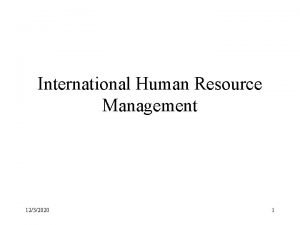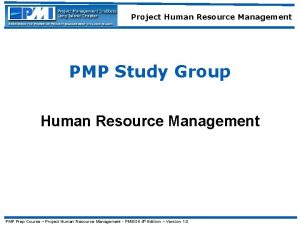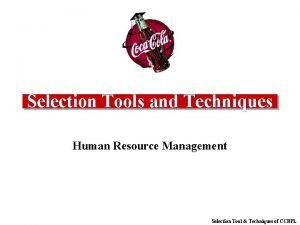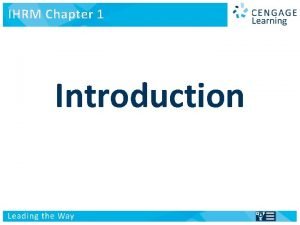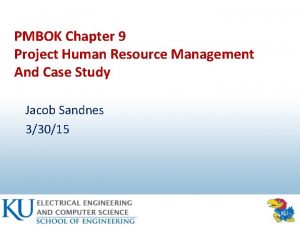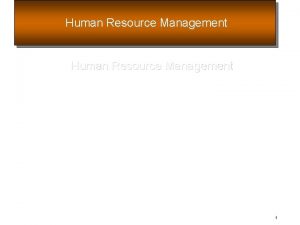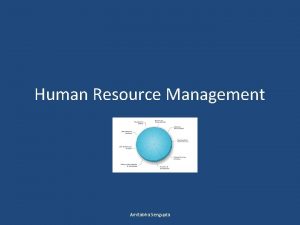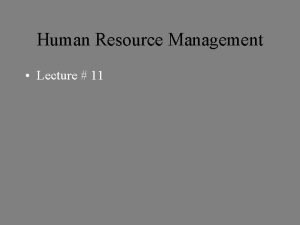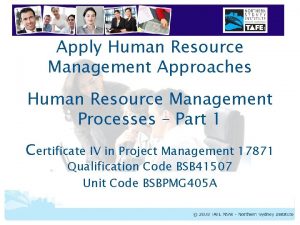Induction and Retention Human Resource Management Definition Induction



















- Slides: 19

Induction and Retention Human Resource Management

Definition: Induction Taylor (2002) says the following about induction. ‘Induction is used as a general term describing the whole process whereby new employees adjust or acclimatise to their jobs and working environment. ’ 2

The purpose of induction Michael Armstrong proposes that induction serves four purposes: �to smooth the preliminary stages when everything is strange and unfamiliar with the new starter �to establish quickly a favourable attitude to the company in the mind of the new employee so that he or she is more likely to stay �to obtain effective output from the employee in shortest possible time �to reduce the likelihood of the employee leaving quickly. 3

The importance of induction Induction at its extreme is the first opportunity to introduce the individual into the company’s culture, its norms, standards (values) and expected behaviours. 4

Indications of a successful induction process � New employees taking little time to become � � effective in their jobs. An increase in the rate at which employees adapt to their surroundings. Good interpersonal relations between new and longer-serving employees. A reduction in staff turnover, thus reducing recruitment costs and disruption to workplace productivity. A satisfactory staff retention rate and stability index. 5

Definition: socialisation �Socialisation is the process through which individuals become familiar with their environment and learn about the kind of behaviours that are expected of them. �It is experienced in our early development years and what we learn then stays with us for the rest of our lives. �When we enter an organisation, we go through it all again. This time it is kind of microsocialisation, which involves learning a culture which is different from that of the outside world and different from that of any other organisation. 6

The induction crisis As the new employee begins to get to know the job and the organisation, there may be second thoughts about the original decision they made to join the organisation. He or she may decide to leave. The strengths of these feelings depends upon the degree to which the job and the organisation match up to the employee’s expectations and, in some cases, employer promises. 7

Definition: accommodation �In the context of a new experience, accommodation is the process in which individuals alter their perception of a situation so that the original perception is replaced by the new one. �People do this when they discover that things are not what they thought they would be. 8

Approaches to induction �In writing, in which the new employee is presented with an induction pack. �Walk ’n’ talk, in which the new employee is shown around the site and is given explanations about each work activity on the way around the facilities. �Induction training: the approach takes the form of a number of training sessions, each of which deals with a particular aspect of work and each is usually delivered by a specialist in that subject area. �Coaching and mentoring is also used in many organisations to help the new starter over the longer term. 9

Inducting minority groups or those with special needs � Care needs to be taken when inducting employees who are new to this country or who have special needs, perhaps because of a disability or who have special educational needs. � The speed and type of delivery or even lack of understanding of the English language may seriously impair the effectiveness of the induction process. � Think of the worst-case scenario where the programme is addressing health and safety matters and there is a clear requirement for the inductees to go away with a uniform vision of how company views health and safety in the workplace. 10

Promoting equality in the organisation The Commission for Racial Equality (CRE) (which was superseded by the Equality and Human Rights Commission) suggested the following ways to promote equality within the organisation: �review recruitment, selection and training procedures regularly �draw up clear and justifiable job criteria which are demonstrably objective and job-related �offer pre-employment training, where appropriate, to prepare potential job applicants for selection tests and interviews �consider positive action (see following ‘Legal Point’ panel), to help ethnic minority (one could also include those with special needs because of, for example, a disability) employees to apply for jobs in areas where they are underrepresented. 11

Positive action The Equality and Human Rights Commission says the following about positive discrimination: ‘Where members of the relevant sex or racial group are under-represented, there are limited exceptions allowing discrimination in training, or encouragement to apply for particular work. These lawful exceptions are often referred to as positive action. ’ 12

training Where particular racial groups have been under- represented in particular work at any time in the past 12 months, the Race Relations Act 1976, Part VI (now incorporated in EA 2010 allows positive action measures to be taken in order to: �encourage applications for an under-represented group for vacancies in particular work �provide training in order to help to fit members of an under-represented group for the particular work. 13

Terms and conditions of employment The induction training environment is an ideal place in which to provide the new employees with a copy of the particulars of their main terms and conditions of employment (service). It is advisable to make this a discrete event, rather than issue these along with a sheaf of other documents which may be stowed in the induction pack never to be opened. 14

handbook The company handbook will include the following type of information: � payment systems, including the frequency of payments and the � � � � deductions that are made, eg tax, National Insurance, pension deductions holiday entitlement holiday and sick pay arrangements sickness absence procedure promotion policy discrimination and equal opportunities policy health and safety policy disciplinary rules grievance procedures education and training policy provision for employees’ well-being available benefits and facilities trade union and joint consultation arrangements special working arrangement overseas (if applicable). 15

induction The departmental induction, as well as forming a first and formal introduction to colleagues and supervisor, is also concerned with the technicalities and other details of the job itself. The idea is to settle down the new starter into his/her new place of work and to try to make him/her feel welcome. Induction interviews should be given to all employees taking up jobs for the first time, whether the person has been recruited from outside the organisation or promoted from within. 16

Induction interviews should cover the following points: � The job description and person specification so that the � � � job-holder understands what is required. How the job relates to the work and purposes of the group and the organisation as a whole. All the attendant circumstances of the job, eg pay, conditions, welfare, etc. The performance appraisal system and what part of the job -holder will be required to play. An assessment of any training and development needs that require immediate action. General plans for training and development. Career prospects. 17

Retention plan � Pay and benefits: competitive rates of pay, deferred compensation, eg share option schemes, generous pension schemes [although these may not be final salary schemes – author comments], retention bonuses, flexible benefits, benefits package that improves with service. � Recruitment and selection: set appropriate standards, match people to posts, provide an accurate picture of the job. � Training and development: good induction processes, provision of development opportunities to meet the needs of the individual and the organisation, structured career paths. 18

continued � Job design: provision of interesting work, as much autonomy and team working as possible, opportunities for flexible working to meet the needs of the individual. � Management: ensure managers and supervisors have the skills to manage and coach their staff effectively. � Make changes to improve work−life balance. � Offer coaching mentoring/buddying systems. 19
 Purpose of induction
Purpose of induction Time management human resources
Time management human resources Retail organization
Retail organization Role of personnel management
Role of personnel management Defination of hrm
Defination of hrm Introduction to hrm
Introduction to hrm What is decruitment
What is decruitment Project human resource management definition
Project human resource management definition Sample hrm exam questions
Sample hrm exam questions Human resource management strategy and analysis
Human resource management strategy and analysis Human resources and job design
Human resources and job design Define human resource management and payroll cycle
Define human resource management and payroll cycle Selection in human resource management
Selection in human resource management Hr selectietool
Hr selectietool Domestic and international human resource management
Domestic and international human resource management Project human resource management pmbok ppt
Project human resource management pmbok ppt Pmbok human resource management
Pmbok human resource management Importance of human resource managment
Importance of human resource managment Human resource management in restaurants
Human resource management in restaurants Hrm chapter 2
Hrm chapter 2




